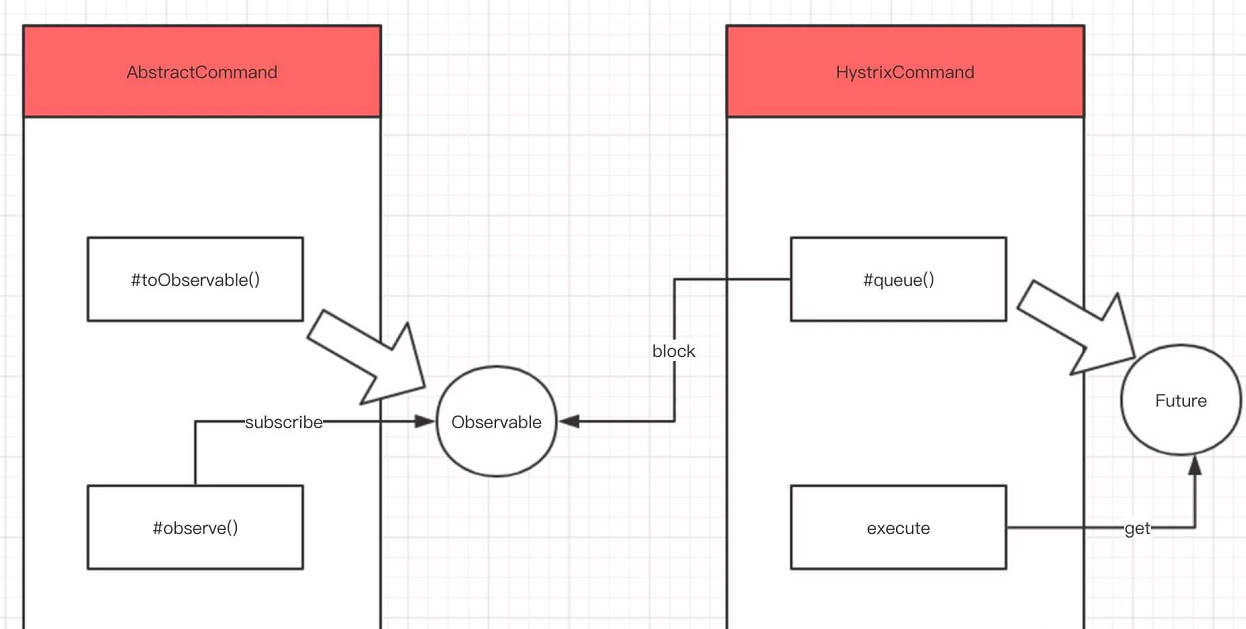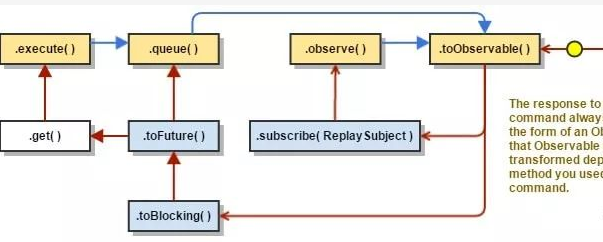本文主要基于 Hystrix 1.5.X 版本
-
1. 概述
-
2. 实现
-
3. BlockingObservable
1. 概述
本文主要分享 Hystrix 执行命令方法。
建议 :对 RxJava 已经有一定的了解的基础上阅读本文。
在官方提供的示例中,我们看到 CommandHelloWorld 通过继承 HystrixCommand 抽象类,有四种调用方式:
| 方法 | |
|---|---|
#execute() |
同步调用,返回直接结果 |
#queue() |
异步调用,返回 java.util.concurrent.Future |
#observe() |
异步调用,返回 rx.Observable 。向 Observable 注册 rx.Subscriber处理结果 |
#toObservable() |
未调用,返回 rx.Observable 。向 Observable 注册 rx.Subscriber处理结果 |
|
|
|
|
|
2. 实现
// AbstractCommand.java
abstract class AbstractCommand<R> implements HystrixInvokableInfo<R>, HystrixObservable<R> {
// ... 省略无关属性与方法
public Observable<R> toObservable() {
return Observable.defer(new Func0<Observable<R>>() {
@Override
public Observable<R> call() {
// ....
}
}
}
public Observable<R> observe() {
// us a ReplaySubject to buffer the eagerly subscribed-to Observable
ReplaySubject<R> subject = ReplaySubject.create();
// eagerly kick off subscription
final Subscription sourceSubscription = toObservable().subscribe(subject);
// return the subject that can be subscribed to later while the execution has already started
return subject.doOnUnsubscribe(new Action0() {
@Override
public void call() {
sourceSubscription.unsubscribe();
}
});
}
}
// HystrixCommand.java
public abstract class HystrixCommand<R> extends AbstractCommand<R> implements HystrixExecutable<R>, HystrixInvokableInfo<R>, HystrixObservable<R> {
// ... 省略无关属性与方法
public Future<R> queue() {
final Future<R> delegate = toObservable().toBlocking().toFuture();
final Future<R> f = new Future<R>() {
// ... 包装 delegate
}
// ...
return f;
}
public R execute() {
try {
return queue().get();
} catch (Exception e) {
throw Exceptions.sneakyThrow(decomposeException(e));
}
}
protected abstract R run() throws Exception;
}-
#toObservable()方法 :未做订阅,返回干净的 Observable 。这就是为什么上文说“未调用” 。 -
#observe()方法 :调用#toObservable()方法的基础上,向 Observable 注册rx.subjects.ReplaySubject发起订阅 。ReplaySubject 会发射所有来自原始 Observable 的数据给观察者,无论它们是何时订阅的。感兴趣的同学可以阅读 《ReactiveX/RxJava文档中文版 —— Subject》 。 -
#queue()方法 :调用#toObservable()方法的基础上,调用:-
#run()方法 :子类实现该方法,执行正常的业务逻辑。
-
Observable#toBlocking()方法 :将 Observable 转换成阻塞的rx.observables.BlockingObservable。 -
BlockingObservable#toFuture()方法 :返回可获得#run()抽象方法执行结果的 Future 。
-
-
BlockingObservable 在 「3. BlockingObservable」 详细解析。
-
#execute()方法 :调用#queue()方法的基础上,调用Future#get()方法,同步返回#run()的执行结果。 -
整理四种调用方式如下:



3. BlockingObservable
本小节为拓展内容,源码解析 RxJava ( 非 Hystrix ) 的 rx.observables.BlockingObservable 的实现,所以你可以选择:
-
1 ) 跳过本小节,不影响对本文的理解。
-
2 ) 选择阅读 《ReactiveX/RxJava文档中文版 —— 阻塞操作》 ,理解 BlockingObservable 的原理。
-
3 ) 选择阅读本小节,理解 BlockingObservable 的原理以及实现。